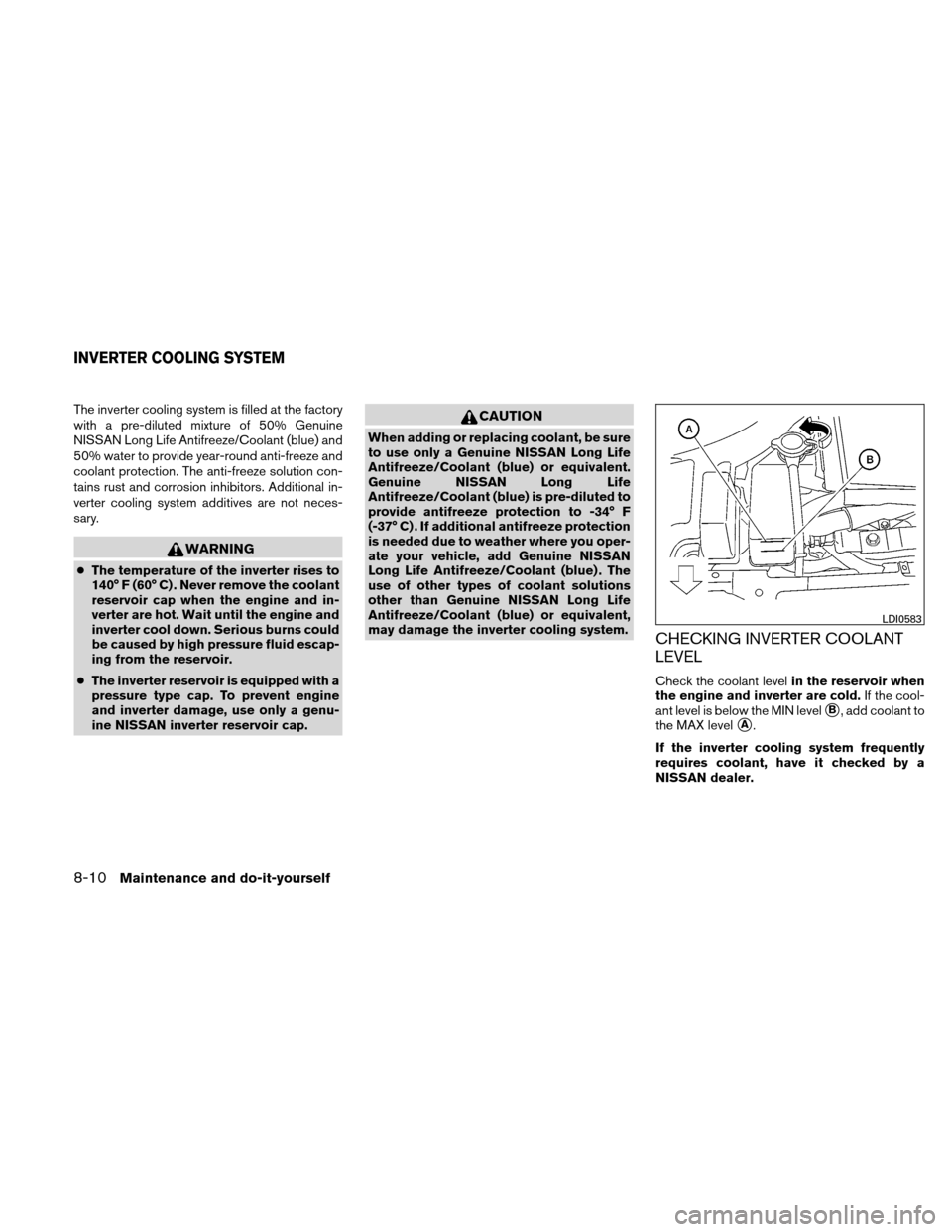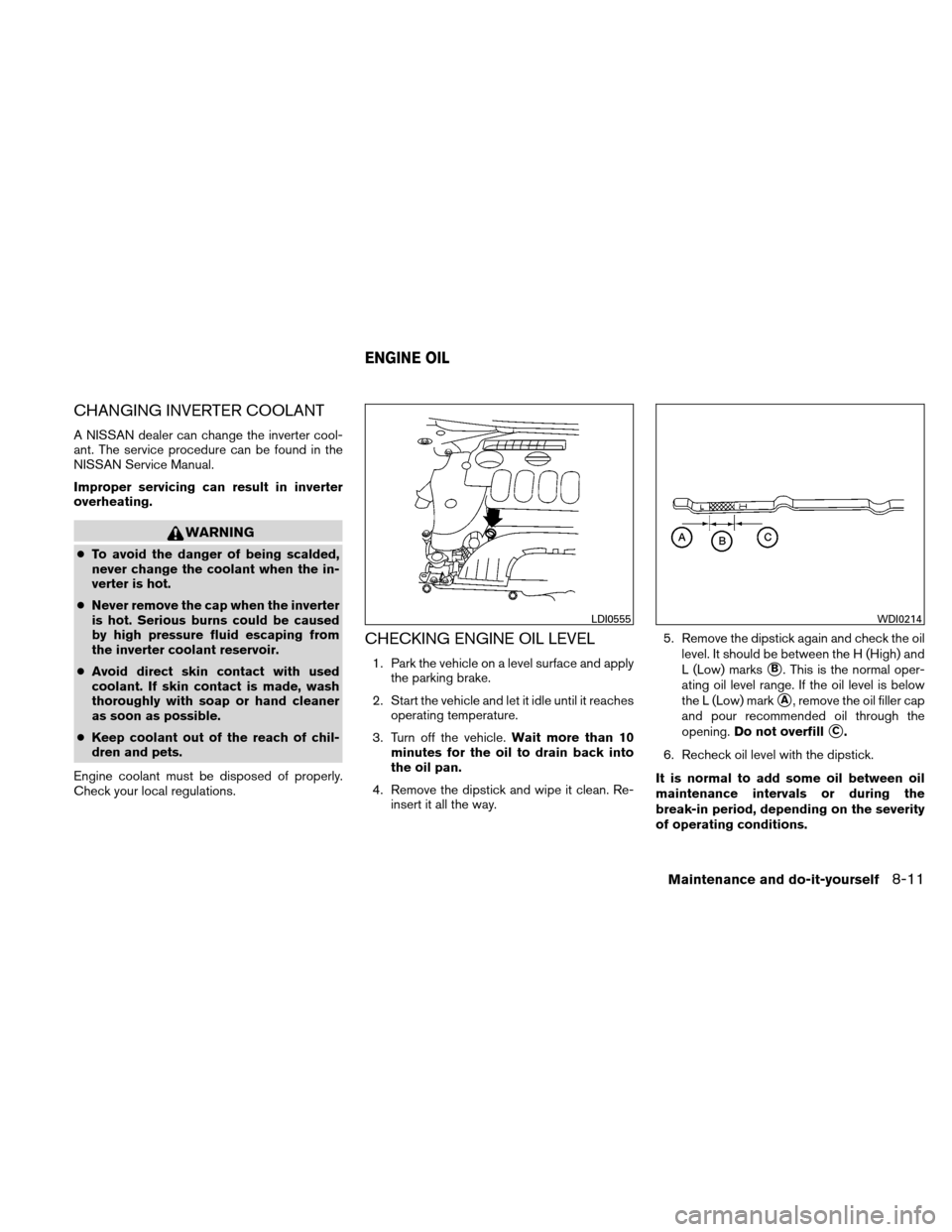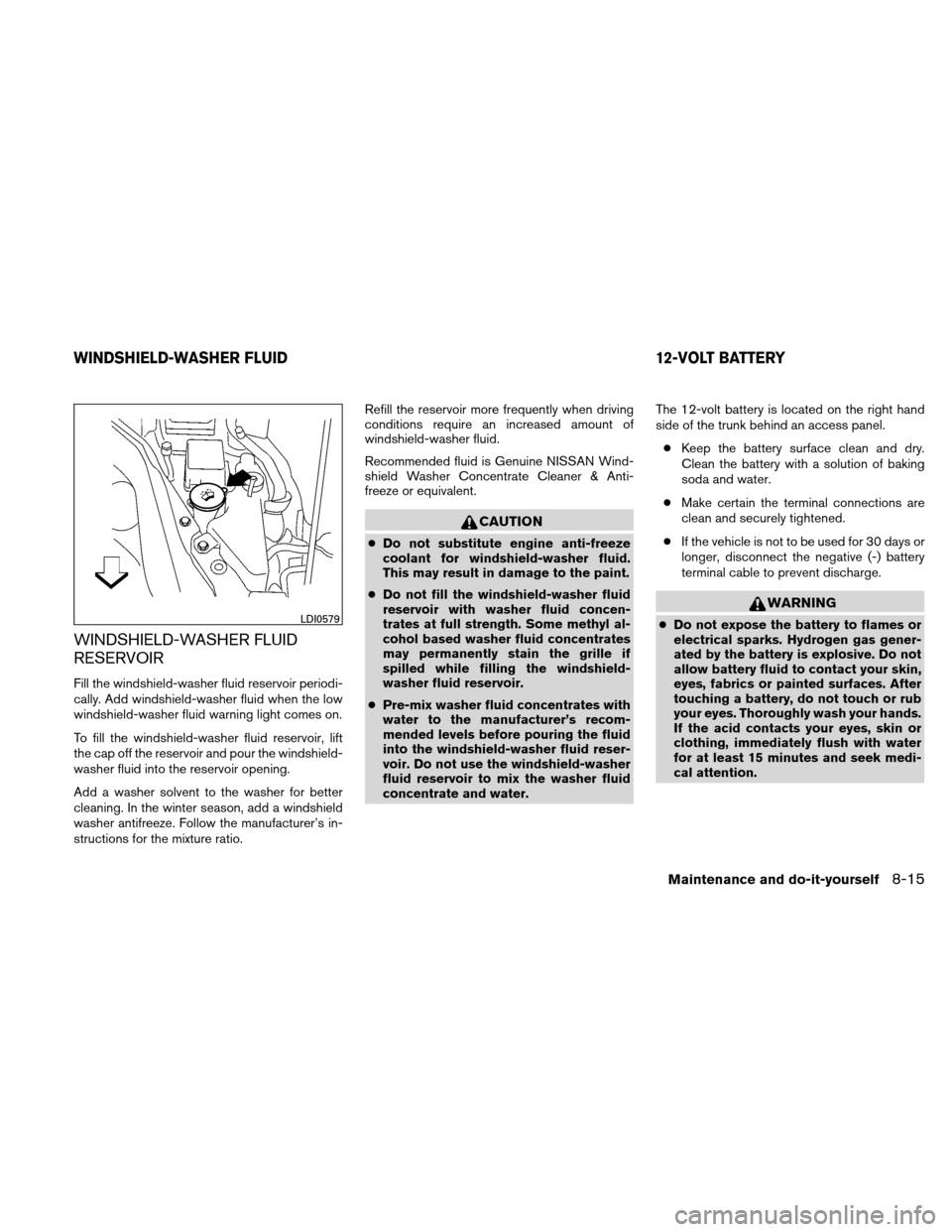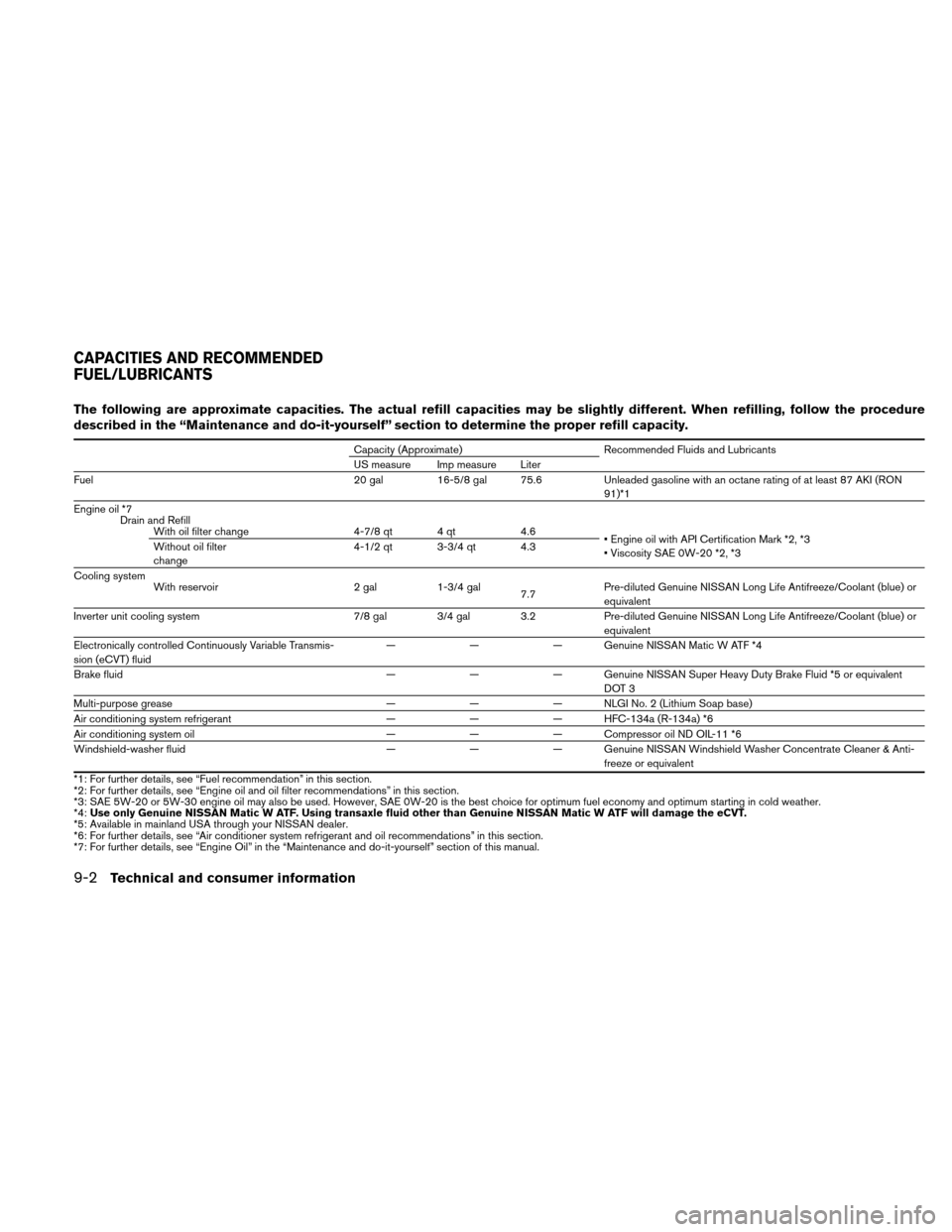Page 351 of 422

The inverter cooling system is filled at the factory
with a pre-diluted mixture of 50% Genuine
NISSAN Long Life Antifreeze/Coolant (blue) and
50% water to provide year-round anti-freeze and
coolant protection. The anti-freeze solution con-
tains rust and corrosion inhibitors. Additional in-
verter cooling system additives are not neces-
sary.
WARNING
●The temperature of the inverter rises to
140° F (60° C) . Never remove the coolant
reservoir cap when the engine and in-
verter are hot. Wait until the engine and
inverter cool down. Serious burns could
be caused by high pressure fluid escap-
ing from the reservoir.
● The inverter reservoir is equipped with a
pressure type cap. To prevent engine
and inverter damage, use only a genu-
ine NISSAN inverter reservoir cap.
CAUTION
When adding or replacing coolant, be sure
to use only a Genuine NISSAN Long Life
Antifreeze/Coolant (blue) or equivalent.
Genuine NISSAN Long Life
Antifreeze/Coolant (blue) is pre-diluted to
provide antifreeze protection to -34° F
(-37° C) . If additional antifreeze protection
is needed due to weather where you oper-
ate your vehicle, add Genuine NISSAN
Long Life Antifreeze/Coolant (blue) . The
use of other types of coolant solutions
other than Genuine NISSAN Long Life
Antifreeze/Coolant (blue) or equivalent,
may damage the inverter cooling system.
CHECKING INVERTER COOLANT
LEVEL
Check the coolant level in the reservoir when
the engine and inverter are cold. If the cool-
ant level is below the MIN level
�B, add coolant to
the MAX level
�A.
If the inverter cooling system frequently
requires coolant, have it checked by a
NISSAN dealer.
LDI0583
INVERTER COOLING SYSTEM
8-10Maintenance and do-it-yourself
Page 352 of 422

CHANGING INVERTER COOLANT
A NISSAN dealer can change the inverter cool-
ant. The service procedure can be found in the
NISSAN Service Manual.
Improper servicing can result in inverter
overheating.
WARNING
●To avoid the danger of being scalded,
never change the coolant when the in-
verter is hot.
● Never remove the cap when the inverter
is hot. Serious burns could be caused
by high pressure fluid escaping from
the inverter coolant reservoir.
● Avoid direct skin contact with used
coolant. If skin contact is made, wash
thoroughly with soap or hand cleaner
as soon as possible.
● Keep coolant out of the reach of chil-
dren and pets.
Engine coolant must be disposed of properly.
Check your local regulations.
CHECKING ENGINE OIL LEVEL
1. Park the vehicle on a level surface and apply the parking brake.
2. Start the vehicle and let it idle until it reaches operating temperature.
3. Turn off the vehicle. Wait more than 10
minutes for the oil to drain back into
the oil pan.
4. Remove the dipstick and wipe it clean. Re- insert it all the way. 5. Remove the dipstick again and check the oil
level. It should be between the H (High) and
L (Low) marks�B. This is the normal oper-
ating oil level range. If the oil level is below
the L (Low) mark
�A, remove the oil filler cap
and pour recommended oil through the
opening. Do not overfill
�C.
6. Recheck oil level with the dipstick.
It is normal to add some oil between oil
maintenance intervals or during the
break-in period, depending on the severity
of operating conditions.
LDI0555WDI0214
ENGINE OIL
Maintenance and do-it-yourself8-11
Page 356 of 422

WINDSHIELD-WASHER FLUID
RESERVOIR
Fill the windshield-washer fluid reservoir periodi-
cally. Add windshield-washer fluid when the low
windshield-washer fluid warning light comes on.
To fill the windshield-washer fluid reservoir, lift
the cap off the reservoir and pour the windshield-
washer fluid into the reservoir opening.
Add a washer solvent to the washer for better
cleaning. In the winter season, add a windshield
washer antifreeze. Follow the manufacturer’s in-
structions for the mixture ratio.Refill the reservoir more frequently when driving
conditions require an increased amount of
windshield-washer fluid.
Recommended fluid is Genuine NISSAN Wind-
shield Washer Concentrate Cleaner & Anti-
freeze or equivalent.
CAUTION
●
Do not substitute engine anti-freeze
coolant for windshield-washer fluid.
This may result in damage to the paint.
● Do not fill the windshield-washer fluid
reservoir with washer fluid concen-
trates at full strength. Some methyl al-
cohol based washer fluid concentrates
may permanently stain the grille if
spilled while filling the windshield-
washer fluid reservoir.
● Pre-mix washer fluid concentrates with
water to the manufacturer’s recom-
mended levels before pouring the fluid
into the windshield-washer fluid reser-
voir. Do not use the windshield-washer
fluid reservoir to mix the washer fluid
concentrate and water. The 12-volt battery is located on the right hand
side of the trunk behind an access panel.
● Keep the battery surface clean and dry.
Clean the battery with a solution of baking
soda and water.
● Make certain the terminal connections are
clean and securely tightened.
● If the vehicle is not to be used for 30 days or
longer, disconnect the negative (-) battery
terminal cable to prevent discharge.
WARNING
● Do not expose the battery to flames or
electrical sparks. Hydrogen gas gener-
ated by the battery is explosive. Do not
allow battery fluid to contact your skin,
eyes, fabrics or painted surfaces. After
touching a battery, do not touch or rub
your eyes. Thoroughly wash your hands.
If the acid contacts your eyes, skin or
clothing, immediately flush with water
for at least 15 minutes and seek medi-
cal attention.LDI0579
WINDSHIELD-WASHER FLUID 12-VOLT BATTERY
Maintenance and do-it-yourself8-15
Page 387 of 422

The following are approximate capacities. The actual refill capacities may be slightly different. When refilling, follow the procedure
described in the “Maintenance and do-it-yourself” section to determine the proper refill capacity.
Capacity (Approximate)Recommended Fluids and Lubricants
US measure Imp measure Liter
Fuel 20 gal 16-5/8 gal 75.6Unleaded gasoline with an octane rating of at least 87 AKI (RON
91)*1
Engine oil *7 Drain and RefillWith oil filter change 4-7/8 qt 4 qt4.6
Engine oil with API Certification Mark *2, *3
Viscosity SAE 0W-20 *2, *3
Without oil filter
change 4-1/2 qt 3-3/4 qt 4.3
Cooling system With reservoir 2 gal1-3/4 gal
7.7 Pre-diluted Genuine NISSAN Long Life Antifreeze/Coolant (blue) or
equivalent
Inverter unit cooling system 7/8 gal 3/4 gal 3.2Pre-diluted Genuine NISSAN Long Life Antifreeze/Coolant (blue) or
equivalent
Electronically controlled Continuously Variable Transmis-
sion (eCVT) fluid —
—— Genuine NISSAN Matic W ATF *4
Brake fluid ——— Genuine NISSAN Super Heavy Duty Brake Fluid *5 or equivalent
DOT 3
Multi-purpose grease ——— NLGI No. 2 (Lithium Soap base)
Air conditioning system refrigerant ——— HFC-134a (R-134a) *6
Air conditioning system oil ——— Compressor oil ND OIL-11 *6
Windshield-washer fluid ——— Genuine NISSAN Windshield Washer Concentrate Cleaner & Anti-
freeze or equivalent
*1: For further details, see “Fuel recommendation” in this section.
*2: For further details, see “Engine oil and oil filter recommendations” in this section.
*3: SAE 5W-20 or 5W-30 engine oil may also be used. However, SAE 0W-20 is the best choice for optimum fuel economy and optimum starting in cold weather.
*4: Use only Genuine NISSAN Matic W ATF. Using transaxle fluid other than Genuine NISSAN Matic W ATF will damage the eCVT.
*5: Available in mainland USA through your NISSAN dealer.
*6: For further details, see “Air conditioner system refrigerant and oil recommendations” in this section.
*7: For further details, see “Engine Oil” in the “Maintenance and do-it-yourself” section of this manual.
CAPACITIES AND RECOMMENDED
FUEL/LUBRICANTS
9-2Technical and consumer information